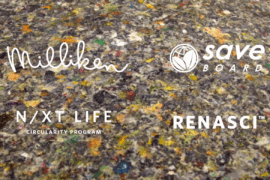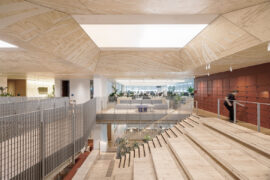Merging heritage principles with pioneering sustainability values, leading professional services company, GHD is playing a major role in shaping Canberra, Australia’s heritage-listed iconic landmark – Shine Dome.

June 16th, 2020
In a project with the University of Canberra, GHD will research and develop optimal approaches for the conservation and sustainable management of Shine Dome.
The driver for the project is the Australian Academy of Science’s goal to minimise their negative impacts on the environment.
Shine Dome (previously called Becker House), designed by Sir Roy Grounds was purpose-built in 1959 as a home for the Australian Academy of Science, featuring some bold architectural ideas for the era. At the time, many people doubted it could be built as nobody knew how to calculate the stresses created by a 710 tonne concrete dome balanced on 16 slender supports, without collapsing.
Shine Dome eventually became Canberra’s first building to be added to the National Heritage List in 2005 and today it remains one of Australia’s most unusually striking buildings.
It houses archive collections from Australia’s most famous scientists including Frank Fenner who helped eradicate smallpox, as well as holding lectures and other events.
“The combination of integrating innovative sustainability components within an existing heritage envelope is a special challenge. We need to preserve the heritage value and at the same time represent the scientific innovation and experimentation that goes hand in hand with the Australian Academy of Science,” says Tai Hollingsbee, GHD’s National Building Engineering Leader – Australia.
GHD’s prior involvement with Shine Dome dates back to 1999, when the company completed the building’s Conservation Management Plan. This history, combined with Tai Hollingsbee’s wide recognition for sustainability expertise were crucial to winning this project.
Based in Melbourne, Tai is widely recognised for his work in building physics, sustainability and the application of technology to improve performance outcomes across a diverse range of complex engineering projects in Australia and globally.
GHD’s team led by Tai will assess the internal and external fabric, building systems, operational profiles and forecast future uses to determine how best to replace old equipment and apply new technology without changing the design.
GHD’s experts will be pivotal to providing the Australian Academy of Science with an environmentally friendly Shine Dome.
“We are looking forward to working with the Academy together with the University of Canberra and combining all of our expertise to achieve something special,” adds Tai.
The complex project will take a full year to complete and is supported by the Australian Government under their Australian Heritage Grant Scheme.
INDESIGN is on instagram
Follow @indesignlive
A searchable and comprehensive guide for specifying leading products and their suppliers
Keep up to date with the latest and greatest from our industry BFF's!

Gaggenau’s understated appliance fuses a carefully calibrated aesthetic of deliberate subtraction with an intuitive dynamism of culinary fluidity, unveiling a delightfully unrestricted spectrum of high-performing creativity.

As French-Lebanese Architect Lina Ghotmeh prepares for lectures in Melbourne and Sydney, we hear about the philosophy shaping her internationally celebrated practice.

Developed by Milliken in partnership with saveBOARD, Renasci™ is a breakthrough circular flooring product made from carpet and soft plastics waste – designed to be repeatedly recycled.

Reuse, resourcefulness and material transformations bring unexpected stories to Arup’s new Brisbane office, designed by Hassell.

The client’s brief was clear: create an environment that honoured FIN’s heritage while embracing its future. For Intermain, that meant rejecting the idea of the corporate, “boring” office and instead leaning into a space that would inspire, connect, and surprise.
The internet never sleeps! Here's the stuff you might have missed

Developed by Milliken in partnership with saveBOARD, Renasci™ is a breakthrough circular flooring product made from carpet and soft plastics waste – designed to be repeatedly recycled.

THISS Studio has completed the interior fit out of a flexible office and creative space in east London for independent communications studio, SALT.